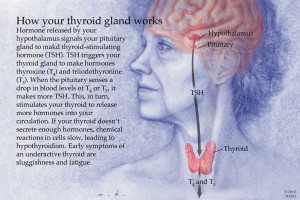-
Mayo Clinic Q and A: Several factors to consider before treating hypothyroidism
DEAR MAYO CLINIC: At my last checkup, my doctor told me I have borderline hypothyroidism and gave me a prescription for medication to treat it. She said she would check my thyroid again in six months. Is this something I will have to take for the rest of my life? What are the risks if I choose not to take the medicine? I am a 62-year-old woman and very healthy.
ANSWER: Before you move forward with treatment for hypothyroidism, it would be worthwhile to wait and repeat the test in several months to confirm your diagnosis. Even if the results are the same at that time, you should consider several other factors before you decide on treatment.
Your thyroid is a small, butterfly-shaped gland at the base of the front of your neck. Hypothyroidism, sometimes called underactive thyroid, is a condition in which your thyroid gland doesn’t produce enough of certain important hormones. The hormones that the thyroid gland makes — triiodothyronine, or T3, and thyroxine, or T4 — have a large impact on your health, affecting all aspects of your metabolism. They maintain the rate at which your body uses fats and carbohydrates, help control your body temperature, influence your heart rate, and help regulate the production of proteins.
The rate at which your thyroid makes T3 and T4 is regulated by another hormone that your pituitary gland produces, called thyroid-stimulating hormone, or TSH. The term “borderline hypothyroidism” typically is used when blood tests show that your body’s level of TSH is slightly above normal, but your T3 and T4 levels are normal. Another name for this condition is subclinical hypothyroidism.
Not all physicians agree on whether there is benefit to treating hypothyroidism at this stage. That’s because treatment typically involves a daily dose of a synthetic hormone, and if you take that medication in excessive doses it can have a negative effect on a variety of your body’s systems, including your brain, heart and muscle function. It also can interfere with how your body handles fluid and fats.
If left untreated, about 30 percent of people whose condition falls into the category of subclinical hypothyroidism have their TSH levels return to normal within one year. Only 3 percent per year will go on to develop the classical form of hypothyroidism. That condition is characterized by elevated TSH levels and low levels of T3 and T4. It requires treatment in all cases.
If a second blood test confirms your diagnosis of subclinical hypothyroidism, there are several factors to consider before you decide on treatment. In general, treatment is recommended if you have symptoms of hypothyroidism, such as fluid retention, fatigue, increased sensitivity to cold, constipation, muscle weakness or painful joints, among others. Treatment also may be necessary if you have another underlying medical condition, such as congestive heart failure or high cholesterol.
In these cases of subclinical hypothyroidism, many physicians recommend treatment for three to six months to see if it helps relieve symptoms. If after the initial course of treatment the symptoms remain, then treatment needs to be re-evaluated.
If you have subclinical hypothyroidism, but you don’t have symptoms or other health problems, then it would be wise to wait with treatment and be tested again in six to 12 months. If your TSH level is significantly higher; if it increases consistently and you have a family history of thyroid disease; or if another blood test finds you have positive anti-thyroid antibodies, therapy would be appropriate at that time. — Marius N. Stan, M.D., Endocrinology, Mayo Clinic, Rochester, Minn.
Related Articles






